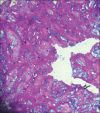Epithelial and stromal patterns of pleomorphic adenoma of minor salivary glands: A histopathological and histochemical study
- PMID: 25948992
- PMCID: PMC4409182
- DOI: 10.4103/0973-029X.151319
Epithelial and stromal patterns of pleomorphic adenoma of minor salivary glands: A histopathological and histochemical study
Abstract
Background: Pleomorphic adenoma (PA) accounts for 45-74% of all the salivary gland neoplasms, of which 40-70% are present in minor salivary glands. Studies have depicted variations in histological typing and classification of these tumors. Its pleomorphism is attributed to the cytological differentiations of the epithelial components and the diverse stromal components. Biochemical investigations of saliva have revealed "mucins" to be its main component. Mucins reflect in their composition, the functional state of the mucosa, both in health and disease. Many reviews on histochemical classification and identification have been put forward to explain the intricacies of mucins; however, no attempts have been made to classify salivary gland tumors based on their mucin profiles and assess its prognostic significance. Thus, this study was executed to analyze the clinical, histopathological and histochemical behavior of PA of minor salivary glands and decipher a correlation.
Materials and methods: Twenty-six diagnosed cases of PA of minor salivary glands and five controls of normal minor salivary glands of the hard palate were included in the study. Blocks were retrieved, sectioned and stained with hematoxylin and eosin (H and E) stain as well as combined Alcian blue (AB)-periodic acid-Schiff (PAS) stains.
Results: The stained slides revealed an array of epithelial and stromal patterns and varying heterogeneity of mucin expression of normal and neoplastic minor salivary glands.
Conclusion: The study elucidated the role of mucins in tumorigenesis and its prognostic implications.
Keywords: Alcian blue-PAS stain; Mucins; Pleomorphic adenoma.
Conflict of interest statement
Figures









References
-
- Henriksson G, Westrin KM, Carlsoo B, Silfverswärd C. Recurrent primary pleomorphic adenomas of salivary gland origin: Intrasurgical rupture, histopathologic features and pseudopodia. Cancer. 1998;82:617–20. - PubMed
-
- Zalewska A, Zwierz K, Zółkowski K, Gindzieński A. Structure and biosynthesis of human salivary mucins. Acta Biochim Pol. 2000;47:1067–79. - PubMed
-
- Hand AR, Pathmanathan D, Field RB. Morphological features of minor salivary gland. Arch Oral Biol. 1999;44:S3–10. - PubMed
-
- Totty BA. Mucins. In: Bancroft JD, Gamble M, editors. Theory and Practice of Histological Techniques. 5th edition. Edinburgh: Churchill Livingstone; 2002. pp. 112–116.
LinkOut - more resources
Full Text Sources
Other Literature Sources

